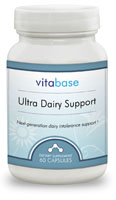| Lactase (or beta-galactosidase) is the enzyme involved in the hydrolysis of lactose to galactose and glucose. Lactase is located in the small intestine that hydrolyses lactose to its components: glucose and galactose. Inner lumen small intestinal cells known as
enterocytes are covered with a membrane that has a brush border. The brush border microvilli produce lactase. Lactase promotes the hydrolysis of the Beta-D galactoside linkage of lactose, converting it into D-glucose and D-galactose. This reactions provides two positive results for dairy products. Lactase is active in the duodenum and its ability to handle lactose loads is very closely related to the amount of lactose emptying from the stomach.
Lactose is an abundant disaccharide which is present in milk and in certain dairy products such as yogurt and whey. Milk is a polynutrient that has many healthy components. Its major carbohydrate is lactose, a disaccharide. Lactose is the sugar making up around 2-8% of the solids in milk. Lactose is a disaccharide consisting of two subunits, a galactose and a glucose linked together. However, the nutritional value of milk is limited because of the fact that a large proportion of the human population lacks the intestinal enzyme lactase. Humans cannot absorb lactose for use as a calorie source unless they can first break it down into its monosaccharide component sugars: glucose and galactose. As a result, the lactose content of milk and other dairy products is not utilized or is only partially utilized by many persons. Although this enzyme is normally present in the intestinal juices and mucosa, investigations have shown that a significant portion of the population is lactose intolerant or lactase deficient.
Lactose intolerance is the inability to digest lactose, a type of sugar found in milk and other dairy products. It is caused by a deficiency of the enzyme lactase. Lactose intolerance occurs when the small intestine does not produce enough of the enzyme lactase. When people with lactose intolerance consume milk products, they may have symptoms such as abdominal bloating, excessive intestinal gas, nausea, diarrhea, and abdominal cramping. Lactase deficiency may also occur as a result of intestinal diseases such as celiac sprue and gastroenteritis, or it may follow gastroduodenal surgery. Temporary lactase deficiency can result from viral and bacterial enteritis, especially in children, when the mucosal cells of the intestine are injured. Lactase supplements can break down lactose and relieve symptoms related to lactose intolerance. Lactase supplements are available without a prescription from many different manufacturers.
Lactase produced commercially can be extracted from yeast fungi such as Kluyveromyces fragilis. Other known sources are other yeasts, and certain bacteria and fungi. The lactase enzyme produced by these organisms generally have pH optimums on the alkaline side or in the weakly acid pH range of about 5-7. The lactase from the yeast source is stable from pH 6.0 to 8.0 and can be used to hydrolyze lactose in neutral pH products. Fungal lactase is effective over a lower range, pH 3.5 to 6.5, making it suitable for milk products and whey in the acidic range. The correct lactase concentration is dependent on the initial concentration of lactose, the degree of hydrolysis required, pH, temperature and the time of hydrolysis. |
 Lactose intolerance is an uncomfortable condition brought on by the body��s inability to digest milk sugar. This happens when the body is deficient in lactase, an enzyme necessary to break down lactose (milk sugar). This unique product is designed for those with dairy food intolerances. Lactose, proteins and fats are contributors to dairy food intolerances, and Ultra Dairy Support contains the enzymes needed to break down all three of these categories. Lactase breaks down dairy products, lipase breaks down fats and protease breaks down proteins. Click here for more information.
Lactose intolerance is an uncomfortable condition brought on by the body��s inability to digest milk sugar. This happens when the body is deficient in lactase, an enzyme necessary to break down lactose (milk sugar). This unique product is designed for those with dairy food intolerances. Lactose, proteins and fats are contributors to dairy food intolerances, and Ultra Dairy Support contains the enzymes needed to break down all three of these categories. Lactase breaks down dairy products, lipase breaks down fats and protease breaks down proteins. Click here for more information.